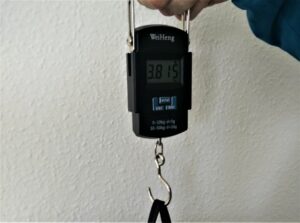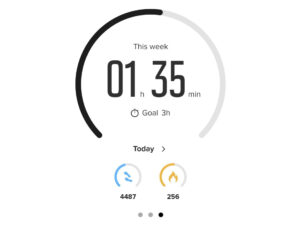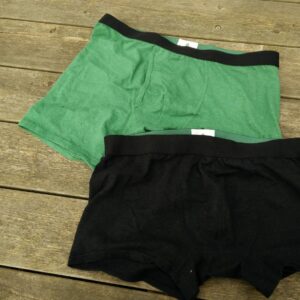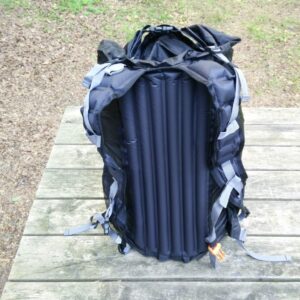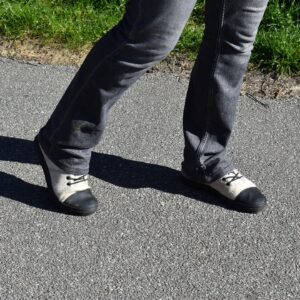In the beginning of the year, I wasn’t particularly happy with my running performance. Due to a busy life, I’ve been running less and less and this really began to frustrate me. Getting more free time for running unfortunately wasn’t an option and thus I got increasingly interested in run commuting. I immediately knew that run commuting every day is not a good option for me because I do have around 7 kilometers (4.3 mi.) to work. Now, I don’t think I’m in bad shape but running 14 kilometers (8.7 mi.) every day would likely result in overtraining. Eventually I decided that I’ll run commute two times a week and only from work to home. Why only from work to home? Well, the route from home to work is mostly downhill and I’m not a big fan of running downhill. Another practical reason for this decision was that I don’t have a shower at work. This could be solved with wet tissues but since I anyway liked the route work-home better, I ditched that idea.
So, one cold morning in March I packed the backpack with running gear and hopped on the bus to work, ready to do my first run commute back home. Since then, I’ve been run commuting regularly and below I’ll give you some practical tips that will make your run commutes more enjoyable and hassle free. These tips are basically what I learned about run commuting so far. If you have questions or would like to share your experience with run commuting, do leave a comment at the bottom of this page.
Plan the route beforehand
You probably know the directions to work because you are commuting there by car or public transport. Nevertheless, that doesn’t mean that that’s the best route for running. If you plan the route beforehand, you can make your run commutes more pleasant by choosing roads and even footpaths away from heavy traffic. Chances are that you can also reduce the length of your runs by finding a shorter route, for example through a forest or a park where vehicles can’t go.
I used the Suunto App to plan my run commuting route, as it has a heatmap feature and automatically syncs routes to my Suunto 9 watch. The heatmap shows where runners often run and is very useful for finding nice running routes. Nevertheless, I couldn’t avoid running around 2 kilometers (1.25 mi.) through the city center. I hate that stretch because there is always a lot of people on the sidewalks and it’s kind of hard to wiggle around them. Another thing that bothers me on that stretch are the traffic lights. I recommend taking some time to properly plan the route. If possible, steer clear of roads with heavy traffic and areas with a lot of people.
It’s important what kind of backpack you wear

Run Commuting: The backpack should be lightweight with comfortable shoulder straps, sternum strap and a hip belt
A good backpack and running shoes are a must when it comes to run commuting. The backpack should be big enough for the stuff you need but not too big. It should also be lightweight and designed for running or at least speed hiking. I started run commuting with my girlfriend’s CamelBak Rim Runner backpack (it’s a unisex pack) and although I had some doubts in the beginning it turned out that the pack is great for run commuting. It weighs only 730 grams (25 oz.) and there is almost no bounce when the backpack is adjusted correctly in terms of shoulder strap length, hip belt and sternum strap. With the volume of 22 liters, it also exactly fits all the stuff I need in colder months.
If you are buying a new backpack for run commuting, I recommend that you first figure out how big a backpack do you need. Then go for a lightweight running or speed hiking pack which has comfortable shoulder straps, a hip belt and a sternum strap. If you need very little storage capacity, check out also running vests such as Nathan VaporAir 2.0. I recommend trying the backpack before you buy it so that you are sure it fits you well.
Don’t overpack
I recommend packing as light as possible because a heavy backpack doesn’t only make you slower, but also increases the chance of injuries. Naturally, it’s easier to pack lightweight in the summer than in the cold months. In early spring my backpack weighed from 4-5 kilos (9-11 lbs.) while in the summer it got as light as 3 kilos (6.6 lbs.). I always pack only essential items and I replaced heavy items with lightweight alternatives. For example, my casual winter jacket weighs over a kilo (2 lbs.) and thus I instead wear my CimAlp Primaloft hiking jacket when I run commute back home. By doing this I reduce the weight of my pack for no less than half of a kilo (1 lb.). I also avoid wearing jeans on run commuting days because jeans are much heavier than pants made of lighter fabrics.
Don’t overdo it
You might be tempted to start run commuting every day from the get go, but I think that that’s a bad idea for most people. Running with a backpack puts extra strain on your muscles and joints. Therefore, you should give your body time to adapt to the extra weight. Start slow and then increase the load if you feel like it. When I started run commuting, I was surprised how much more demanding it is to run with a backpack (especially uphill), although my pack never weighed more than 5 kilos (1 lbs.). Nevertheless, my progress was in the first months also incredibly fast. I could literally see improvements in speed from week to week. If you don’t overdo it the body will quickly adapt to the extra load on your back and you’ll also steer clear of injuries.
Mind the food
Now, optimally you shouldn’t eat just before you go running and of course you also shouldn’t go running hungry. I typically start my run commute back home at 4pm and I have lunch at noon. I quickly figured out that by 4pm I’m too hungry for running. Therefore, I started bringing an energy bar to work which I eat approximately 45 minutes before I start my run commute. If you are planning to run commute to work in the mornings, you should probably wake a bit earlier so that there is at least 30 minutes between the breakfast and the run commute. You should also opt for a light breakfast such as a banana, smoothie or an energy bar.
Conclusion
Run commuting might at first feel like a logistical nightmare but if you plan it well it can save you both workout and/or travel time and money. It’s a great option to get regular exercise if you are low on time and quickly becomes part of routine. You might even discover new areas or running routes in your neighborhood. If you have any questions or your own tips for run commuting, do let me know in the comments below.


